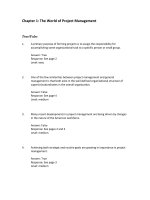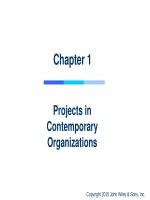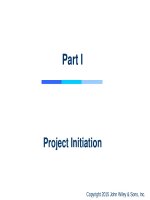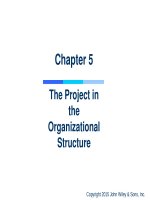Lecture Project management in practice - Chapter 2: Popular frameworks and methodologies
Bạn đang xem bản rút gọn của tài liệu. Xem và tải ngay bản đầy đủ của tài liệu tại đây (736.36 KB, 27 trang )
CHAPTER 2
Popular Frameworks and
Methodologies
Copyright © 2013 McGraw-Hill Education (Australia) Pty Ltd
Pearson, Larson, Gray, Project Management in Practice, 1e
2-1
Learning Elements
2.1
Understand the various project management
frameworks available and which suit what
environments.
2.2 Achieve a high-level understanding of
PRINCE2®.
2.3 Achieve a high-level understanding of ISO
21500:2012.
2.4 Understand Agile and where Agile may be
applied to manage projects.
2.5
Further develop your knowledge of PMBoK
the PMBoK life cycle.
Copyright © 2013 McGraw-Hill Education (Australia) Pty Ltd
Pearson, Larson, Gray, Project Management in Practice, 1e
2-2
Frameworks and
Methodologies
Overview of:
• PRINCE2®
• ISO 21500:2012
• Agile
• PMBoK (5th edition).
Copyright © 2013 McGraw-Hill Education (Australia) Pty Ltd
Pearson, Larson, Gray, Project Management in Practice, 1e
2-3
PRINCE2®
• Initially developed by the UK Office of
Government Commerce (now the
Cabinet Office).
• The PRINCE2® methodology offers
non-proprietary best practice guidance
on project management.
Copyright © 2013 McGraw-Hill Education (Australia) Pty Ltd
Pearson, Larson, Gray, Project Management in Practice, 1e
2-4
PRINCE2 – Components
®
Principles
• There are seven
principles in PRINCE2®.
• All must be applied for
the project to be
PRINCE2®.
• They represent guiding
obligations and good
practice.
• Continued business
justification
• Learn from
experience
• Defined roles and
responsibilities
• Manage by stages
• Manage by
exception
• Focus on products
• Tailor accordingly
Copyright © 2013 McGraw-Hill Education (Australia) Pty Ltd
Pearson, Larson, Gray, Project Management in Practice, 1e
2-5
PRINCE2 – Components
®
(cont.)
Themes
• PRINCE2 encompasses
seven themes.
®
• The themes describe
aspects of project
management that must
continually be attended to
throughout the life of the
project.
• Business case
• Organisation
• Quality
• Plans
• Risk
• Change
• Progress
Copyright © 2013 McGraw-Hill Education (Australia) Pty Ltd
Pearson, Larson, Gray, Project Management in Practice, 1e
2-6
PRINCE2® – Components
(cont.)
Processes
• There are seven
processes.
• They detail the steps to
be taken throughout the
life of a PRINCE2®
project.
• Starting a project
• Initiating a project
• Directing a project
• Managing a stage
boundary
• Controlling a stage
• Managing product
delivery
• Closing a project
Copyright © 2013 McGraw-Hill Education (Australia) Pty Ltd
Pearson, Larson, Gray, Project Management in Practice, 1e
2-7
PRINCE2® – Components
(cont.)
Tailoring
• Tailoring the process to your company’s
environment.
• Not omitting any steps or components.
Copyright © 2013 McGraw-Hill Education (Australia) Pty Ltd
Pearson, Larson, Gray, Project Management in Practice, 1e
2-8
PRINCE2 – Processes
®
Copyright © 2013 McGraw-Hill Education (Australia) Pty Ltd
Pearson, Larson, Gray, Project Management in Practice, 1e
2-9
ISO 21500:2012
• Can be described as guidance for project
management.
• Provides a high-level description of the
concepts and processes considered to
form‘good practice’in project
management.
Copyright © 2013 McGraw-Hill Education (Australia) Pty Ltd
Pearson, Larson, Gray, Project Management in Practice, 1e
2-10
ISO 21500: 2012 Overview
Insert Figure 2.3
Copyright © 2013 McGraw-Hill Education (Australia) Pty Ltd
Pearson, Larson, Gray, Project Management in Practice, 1e
2-11
ISO 21500: 2012 Life Cycle
Copyright © 2013 McGraw-Hill Education (Australia) Pty Ltd
Pearson, Larson, Gray, Project Management in Practice, 1e
2-12
Agile
• Is related to the rolling wave planning and
scheduling project methodology.
• Uses iterations (time boxes) to develop a
workable product that satisfies the
customer and other key stakeholders.
Copyright © 2013 McGraw-Hill Education (Australia) Pty Ltd
Pearson, Larson, Gray, Project Management in Practice, 1e
2-13
Agile (cont.)
• Stakeholders and customers review
progress and re-evaluate priorities to
ensure alignment with customer needs
and company goals.
• Adjustments are made and a different
iterative cycle begins that subsumes the
work of the previous iterations and adds
new capabilities to the evolving product.
Copyright © 2013 McGraw-Hill Education (Australia) Pty Ltd
Pearson, Larson, Gray, Project Management in Practice, 1e
2-14
Agile – Principles
Focus
Focus on
on customer
customer value
value
Iterative
Iterative and
and incremental
incremental delivery
delivery
Experimentation
Experimentation and
and adaptation
adaptation
Self-organisation
Self-organisation
Continuous
Continuous improvement
improvement
Copyright © 2013 McGraw-Hill Education (Australia) Pty Ltd
Pearson, Larson, Gray, Project Management in Practice, 1e
2-15
Agile: Iterative, Incremental
Product Development
Copyright © 2013 McGraw-Hill Education (Australia) Pty Ltd
Pearson, Larson, Gray, Project Management in Practice, 1e
2-16
Agile and Project Uncertainty
Copyright © 2013 McGraw-Hill Education (Australia) Pty Ltd
Pearson, Larson, Gray, Project Management in Practice, 1e
2-17
PMBoK (5 edition)
th
• PMI’s Project Management Body of
Knowledge (PMBoK) provides a generic life
cycle approach.
• Can be applied to projects of all sizes and
complexities, all industries and governments.
Copyright © 2013 McGraw-Hill Education (Australia) Pty Ltd
Pearson, Larson, Gray, Project Management in Practice, 1e
2-18
PMBoK (5 edition) (cont.)
th
• Provides valuable body of knowledge
around project management in general.
• Provides understanding of key tools and
techniques applied in other methodologies
and frameworks such as PRINCE2®,
ISO21500:2012 and Agile.
Copyright © 2013 McGraw-Hill Education (Australia) Pty Ltd
Pearson, Larson, Gray, Project Management in Practice, 1e
2-19
PMBoK – Life Cycle
Copyright © 2013 McGraw-Hill Education (Australia) Pty Ltd
Pearson, Larson, Gray, Project Management in Practice, 1e
2-20
PMBoK – Sequential
Approach
Copyright © 2013 McGraw-Hill Education (Australia) Pty Ltd
Pearson, Larson, Gray, Project Management in Practice, 1e
2-21
PMBoK – Overlapping
Approach
• Insert Figure 2.15
Copyright © 2013 McGraw-Hill Education (Australia) Pty Ltd
Pearson, Larson, Gray, Project Management in Practice, 1e
2-22
PMBoK – Iterative Approach
Copyright © 2013 McGraw-Hill Education (Australia) Pty Ltd
Pearson, Larson, Gray, Project Management in Practice, 1e
2-23
PMBoK – Knowledge Areas
•
•
•
•
•
Scope
Time
Cost
Quality
Human
Resources
•
•
•
•
•
Communications
Risk
Procurement
Stakeholders
Integration
Copyright © 2013 McGraw-Hill Education (Australia) Pty Ltd
Pearson, Larson, Gray, Project Management in Practice, 1e
2-24
PMBoK – Governance and Gates
• Insert Figure 2.18
Copyright © 2013 McGraw-Hill Education (Australia) Pty Ltd
Pearson, Larson, Gray, Project Management in Practice, 1e
2-25









